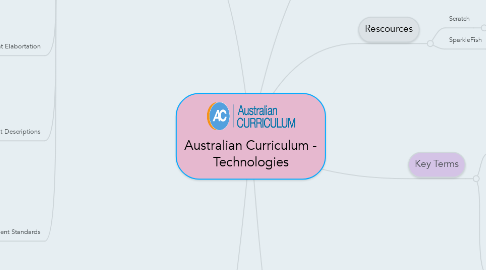
1. Curriculum Organisation
1.1. Subjects
1.1.1. Digital Technologies
1.1.1.1. Knowledge and Understanding
1.1.1.1.1. Digital Systems
1.1.1.1.2. Representation of dData
1.1.1.2. Processes and Production Skills
1.1.1.2.1. Collecting, Managing and Analysing Data
1.1.2. Design and Technologies
1.1.2.1. Knowledge and Understanding
1.1.2.1.1. Technologies and Society
1.1.2.1.2. Technologies Contexts
1.1.2.2. Processes and Production Skills
1.1.2.2.1. Creating Designed Solutions
1.2. Strands
1.2.1. Knowledge and Understanding
1.2.2. Processes and Production Skills
1.3. Band Levels
1.3.1. Foundation to Year 2
1.3.2. Years 3 and 4
1.3.3. Years 5 and 6
1.3.4. Years 7 and 8
1.3.5. Years 9 and 10
1.4. Content Elabortation
1.4.1. Support material to illustrate and exemplify what is to be taught.
1.4.2. Assist teachers in developing a shared understanding of the content descriptions.
1.5. Content Descriptions
1.5.1. Describe the knowledge, understanding and skills that teachers are expected to teach and students are expected to learn.
1.5.2. Written to ensure that learning is ordered appropriately and that unnecessary repetition is avoided.
1.5.3. Grouped to illustrate the clarity and sequence of development of concepts through and across the band levels.
1.6. Achievement Standards
1.6.1. Indicates the quality of learning that students should typically demonstrate by a particular point in their schooling.
1.6.2. Describes progress in the learning area.
1.6.3. Provides teachers with a framework of growth and development in each Technologies subject.
2. Content Items Covered
2.1. Curriculum Aims and Objectives
2.1.1. Investigate, design, plan, manage, create and evaluate solutions.
2.1.2. Support the growth of creative, innovative students when using traditional, contemporary and emerging technologies.
2.1.3. Understand how technologies have developed over time.
2.1.4. Make informed and ethical decisions about the tole, impact and use of technology in the economy, environment and society for a sustainable future.
2.1.5. Engage confidently with and responsibly select and manipulate appropriate technologies (materials, data, systems, components, tools and equipment).
2.1.6. Critique, analyse and evaluate problems, needs or opportunities to identify and create solutions.
2.2. General Capabilities
2.2.1. Literacy
2.2.2. Numeracy
2.2.3. Information and Communication Technology Capability
2.2.4. Critical and Creative Thinking
2.2.5. Personal and Social Capability
2.2.6. Ethical Understanding
2.2.7. Intercultural Understanding
3. Key Terms
3.1. Key Concepts
3.1.1. Abstraction - data representation and specification, algorithms and implementation
3.1.2. Data
3.1.2.1. Collection
3.1.2.1.1. Properties and Sources
3.1.2.2. Representation
3.1.2.2.1. Symbolism and Seperation
3.1.2.3. Interpretation
3.1.2.3.1. Patterns and Contexts
3.1.3. Specification
3.1.3.1. Descriptions and Techniques
3.1.4. Algorithms
3.1.4.1. Following and Describing
3.1.5. Implementation
3.1.5.1. Translating and Programming
3.1.6. Digital Systems
3.1.6.1. Hardware, Software, Networks and the Internet
3.1.7. Interactions
3.1.7.1. People and Digital Systems, Data and Processes and Impacts
3.2. Key Ideas
3.2.1. Systems Thinking - Creating Preferred Futures
3.2.2. Project Management
4. Other Learning Areas and STEM/STEAM
4.1. Cross-Curriculum Priorities
4.1.1. Aboriginal and Torres Strait Islander Histories and Cultures
4.1.2. Asia and Australia's engagement with Asia
4.1.3. Sustainability
4.2. Student Diversity
4.2.1. Teachers cater for the diverse needs of students across Australia and to personalise their learning.
4.2.1.1. Students with Disability
4.2.1.2. English as an Additional Language or Dialect
4.2.1.3. Gifted and Talented Students
5. Australian Curriculum (ACARA) vs West Australian Syllabus K-10
5.1. The West Australian Syllabus K-10 has adopted and adapted ACARA's curriculum content and developed year-level syllabuses for Humanities and Social Sciences, Health and Physical Education, Technologies, The Arts and Languages.
5.2. The Western Australian syllabuses remain broadly consistent with the Australian curriculum but have been contextualised to make them more suitable for Western Australian students and teachers.
5.3. The Australian curriculum, developed by ACARA, was written in bands for Health and Physical Education, Technologies and The Arts, whereas the Western Australian curriculum has year-level syllabuses in each of these learning areas.
6. Rescources
6.1. Scratch
6.1.1. http://dtm4260.edublogs.org/2016/07/31/scratch-6/
6.2. SparkleFish
6.2.1. http://dtm4260.edublogs.org/2016/07/31/sparklefish-2/
